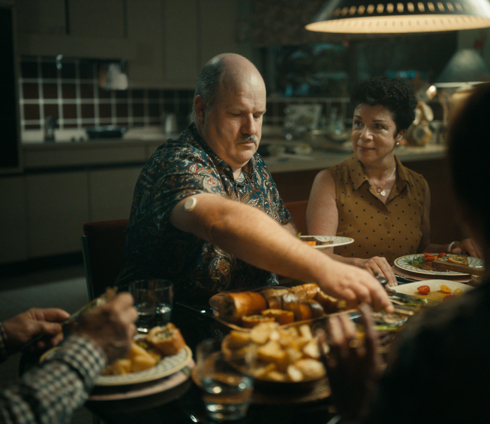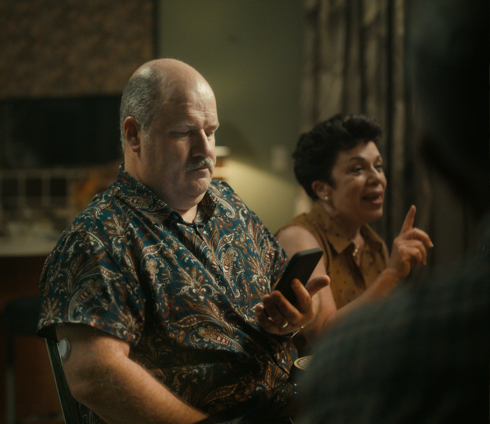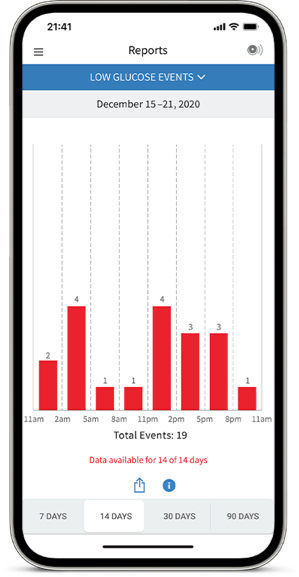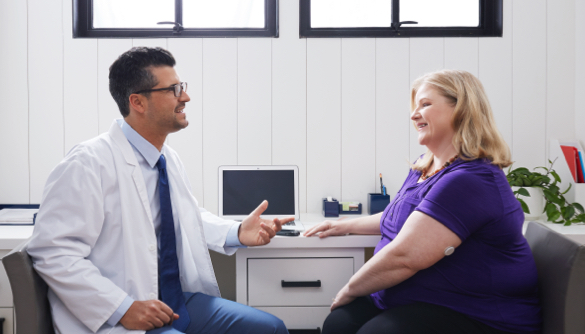A1C is a measurement of your average glucose levels over the past two to three months. It’s used by healthcare professionals to measure how well your diabetes is being managed and is given as a percentage.1
The goal for most people with type 1 or type 2 diabetes is an A1C below 7%.2
Recommended blood sugar levels for most people with diabetes3
This table provides general recommendations on blood sugar targets and may not be the same as the targets your healthcare team has set for you. Your targets should be personalized to you.
|
Target
|
|
|---|---|
|
A1C |
7.0% or under |
|
Fasting blood glucose (sugar)/blood glucose before meals |
4.0-7.0 mmol/L
|
|
Blood glucose (sugar) two hours after eating (mmol/L) |
5.0-10.0 mmol/L
|
Doctors also use different blood sugar tests to diagnose diabetes. In addition to A1C, doctors will do a Fasting Blood Sugar Test (measures blood sugar levels after an overnight fast) and a Glucose Tolerance Test (measures blood sugar levels before and after drinking a sugary liquid).4
|
A1C Test
|
Fasting Blood Sugar Test
|
Glucose Tolerance Test
|
|
|---|---|---|---|
|
Diabetes4 |
6.5% or higher |
7 mmol/L or higher |
11.1 mmol/L or higher |
|
Prediabetes4 |
6.0-6.4% |
6.1-6.9 mmol/L |
7.8-11.0 mmol/L |
|
Normal1,5 |
Under 5.7% |
Under 5.5 mmol/L |
Under 7.8 mmol/L |
When glucose is in your bloodstream, it enters your red blood cells and attaches to a protein called “hemoglobin”. A1C is a measurement of the percentage of hemoglobin in your blood that’s attached to glucose.6
Whatever your A1C, it’s possible to spend a significant amount of time outside of your target glucose range. Your target glucose range is where you and your diabetes care team would like your glucose levels to be.7 This is why Time in Range should be considered in addition to your A1C.
Consider the following example. These three people all have an A1C of 7%. Person A has spent 100% of the time in their target glucose range while persons B and C have not. Persons B and C have a good A1C, but they’re experiencing glucose variability.
Person A
Person B
Person C

Above Target Range (hyperglycemia)

In Target Range

Below Target Range (hypoglycemia)
For illustrative purposes only. Not actual patient data.
The Triangle of Diabetes Care is an approach to managing your diabetes that goes beyond simply lowering your A1C. Although A1C is an important indicator of your glucose control, research suggests that we should also look at other factors for a better picture of glycemic control.8
By targeting each of the three goals of the Triangle of Diabetes Care, you can help make improvements to your wellbeing as well as your long-term health.9 The main three goals are:
Achieving all three of these goals leads to better diabetes management.8,9
The Triangle of Diabetes Care was developed by Dr. Ramzi Ajjan, Associate Professor and
Consultant in Diabetes and Endocrinology at the University of Leeds.
Frequent glucose testing helps you to keep an accurate record of your glucose levels. Real-world evidence has also shown that checking your glucose more frequently is associated with reduced estimated A1C.10
The FreeStyle Libre and FreeStyle Libre 2 systems allow you to see upward or downward trends using the Trend Arrows, and the Daily Patterns report can show you where you have the most variability in your glucose readings from day to day. If you start to see that your glucose runs low or high at specific times of the day, or in response to particular activities, these can be identified so you can make changes in the future.
The Low Glucose Events report on your FreeStyle Libre 2 app* lets you see when and how often your glucose is low throughout a typical day, so you can try and reduce the risk of another hypoglycemic event.
What is it, and what does it mean?
Time in Range refers to the amount of time each day that you spend within your target glucose range.
When setting up your FreeStyle Libre or FreeStyle Libre 2 system for the first time, you need to enter the upper and lower values for the Target Glucose Range in the Settings in the FreeStyle Libre 2 app,* with your healthcare professional’s guidance.
Time in Range is another way of talking about Time in Target, which is one of the reports available on the FreeStyle Libre 2 app.* The more time you spend in your target range, the better.
Time Below Range and Time Above Range are also important measures. The Time in Target report on the FreeStyle Libre 2 app* will show you the percentage of time you’re spending below target range, above target range, and within target range.
In the example below, the Time in Target report shows that this person has spent 22% of the time above target range, 75% of the time within target range, and 3% of the time below target range.

6% Glucose is high

16% Above target range

75% Within target range

3% Glucose is low
Product images are for illustrative purposes only. The examples provided are not intended to be a substitute for professional medical advice. Please consult your physician or qualified health provider regarding your condition and appropriate diabetes plan. Individual symptoms, situations and circumstances may vary.
Expert medical opinion indicates that a target glucose range of 3.9-10 mmol/L should be used to assess Time in Range for most adults with type 1 or type 2 diabetes who are not pregnant, older or considered high-risk.11 Consult with your healthcare team to set target range values that are right for you.
Information from a major clinical trial in people with type 1 diabetes has shown that spending more Time in Range can help to avoid harmful diabetes complications. People in the trial who developed problems with their kidneys or their eyes spent 10-12% less Time in Range on average than those who did not.12
A different study on people with type 2 diabetes showed that vision-threatening diabetic retinopathy (a type of eye condition) was most common in people who spent the least amount of time in their target glucose range, regardless of A1C level.13
More Time in Range
Lower risk of eye and kidney problems
An international group of diabetes experts has recommended that spending at least 70% of your time (~17 hours/day) in range is advisable for most adults with type 1 or type 2 diabetes who are not pregnant, older or considered high-risk.11
Of course, not everyone will be able to meet this target, or at least not right away. Making improvements in Time in Range will vary for each person with diabetes, and that’s okay. Keep in mind that even small increases in Time in Range can have a positive impact.11 So don’t get discouraged - keep checking your glucose regularly and sticking with your diabetes management plan!
Recommended targets for Time in Range, Time Below Range and Time Above Range for most adults with type 1 and type 2 diabetes who are not pregnant, older or considered high-risk11
|
Measure
|
Interpretation
|
Target
|
|
|---|---|---|---|
|
Time in Range |
3.9-10 mmol/L |
- No action needed |
More than 70% |
|
Time Below Range – Level 1 hypoglycemia |
<3.9 mmol/L |
- Action needed if symptoms occur or if extended duration
|
Under 4% |
|
Time Below Range – Level 2 hypoglycemia |
<3.0 mmol/L |
- Immediate action needed
|
Under 1% |
|
Time Above Range – Level 1 hyperglycemia |
>10 mmol/L |
- Low priority for immediate action
|
Under 25% |
|
Time Above Range – Level 2 hyperglycemia |
>13.9 mmol/L |
- Immediate action needed to avoid unwanted effects of hyperglycemia (e.g., diabetic ketoacidosis)
|
Under 5% |
Why is hypoglycemia important?
Common symptoms of hypoglycemia include:15
Shaking
Sweating
Hunger
Nausea
Nervousness
Dizziness
Confusion
Mood swings
Vision changes
Trouble concentrating
Weakness
Difficulty with speech
In general, people will start to experience symptoms of hypoglycemia when their glucose level is under 4.0 mmol/L. When glucose levels fall below 2.8 mmol/L, a person can lose consciousness and will need the assistance of another person.16

Hypoglycemia can make us feel more than just irritable. It can also make us angry and irrational, and in some cases (as with recurrent hypoglycemia) can even lead to anxiety.17

Provoke tense-tiredness (a feeling of being both tense and tired at the same time) and feelings of unhappiness
Increase irritability and anger
Make us pessimistic about everyday situations and about life issues
Lead to mood changes, which are negative, stressful and unpleasant
Lead to anxiety (with repeated episodes of hypoglycemia)
Studies have shown that mental function can be affected when glucose levels fall below 3.0 mmol/L. Below this level, people with diabetes may start to experience problems with:14
Brain
Coma, seizures, mental impairment, psychological effects14
Bones
Falls, accidents, dislocations, driving mishaps14
Heart
Angina (a type of chest pain), abnormal heart rhythms, heart failure14,18
Non-severe hypoglycemia can be self-treated. If you have symptoms of hypoglycemia and your glucose level is less than 3.9 mmol/L, follow these steps:
Severe hypoglycemia has to be treated by other people. The best way to treat severe hypoglycemia is with glucagon - a hormone that raises your glucose levels. Glucagon is available as a nasal spray and injection, and can quickly bring your glucose levels back up. Teach your family, friends and coworkers when and how to give you glucagon. Tell them to call 911 right away after giving you glucagon or if you don’t have a glucagon emergency kit with you.21
The Trend Arrows on your glucose reading can be used to estimate the direction your glucose is heading.
Glucose is rising
Slower rate of change
(0.06-0.1 mmol/L/minute)
Faster rate of change
(more than 0.1 mmol/L/minute)
Glucose is falling
Slower rate of change
(0.06-0.1 mmol/L/minute)
Faster rate of change
(more 0.1 mmol/L/minute)
These arrows are especially useful to know if your glucose is lowering and you might be heading towards a hypo (hypoglycemia).
If you see a downward angled Trend Arrow, you know that your glucose is falling. Knowing this, along with your current reading, you can estimate if this is going to take you into the hypoglycemia zone (below 4.0 mmol/L) and take action to bring your glucose back to target as your healthcare team advised you.
Example: Your glucose reading is 4.4 mmol/L and you have a falling Trend Arrow.
Important note:
Keep in mind that the arrow tilted downwards indicates that your glucose is falling at a slower rate (0.06-0.1 mmol/L per minute), whereas the arrow pointing straight down indicates that your glucose is falling at a faster rate (more than 0.1 mmol/L per minute).
So, in this example, your estimated glucose level in 15 minutes will be between 3.6 mmol/L and 3.0 mmol/L. In this instance, it’s really important to take action right away to stop yourself from having a hypo.
Note: If your glucose is rising and you want to calculate where your glucose level would be in 15 minutes, follow the same steps above. However, in step 2, you will ADD the values to your current glucose reading. So, you would use the following calculation:
[current glucose level] + [change in glucose level] = [estimated glucose level]
IMPORTANT: There are many factors influencing your glucose levels, so although this is handy to know, it’s important to understand that this is only for guidance. Plus, if math just isn’t your thing and you really want to know your glucose reading at any point in time, you can always just re-check your glucose.†
The “Low Glucose Events” report from the FreeStyle Libre and FreeStyle Libre 2 systems are a good way to see if any particular part of your day is contributing to episodes of hypoglycemia (hypos). It puts you in the know, so you can make changes to reduce or even avoid hypos.
The FreeStyle Libre and FreeStyle Libre 2 systems record a Low Glucose Event whenever your glucose has fallen below 3.9 mmol/L for more than 15 minutes. The bar graph displays the low glucose events that happened during different periods of the day - overnight, morning, afternoon or evening.

Results that matter
Studies have shown that FreeStyle Libre users spend less time below 3.9 mmol/L than people who use finger prick blood glucose testing.24,25 This important improvement is not just during the day, but also at night when many people may worry about having a hypo.
Learn how you can use reports from the FreeStyle Libre or FreeStyle Libre 2 system to have a more productive conversation with your doctor.

Sensor is water-resistant in up to 1 metre (3 feet) of water. Do not immerse longer than 30 minutes. Not to be used above 10,000 feet.
* The FreeStyle Libre 2 app and the FreeStyle Libre 2 reader have similar but not identical features. Finger pricks are required if glucose readings and alarms do not match symptoms or expectations. The FreeStyle Libre 2 sensor communicates with the FreeStyle Libre 2 reader that started it or the FreeStyle Libre 2 app that started it. The FreeStyle Libre 2 app is only compatible with certain mobile devices and operating systems. Please check the Compatibility Guide (PDF 69 kB) for more information about device compatibility before using the app. Use of FreeStyle Libre 2 may require registration with LibreView.
† Finger pricks are required if glucose readings and alarms do not match symptoms or expectations.
References:
The FreeStyle Libre 2 flash glucose monitoring system is indicated for measuring interstitial fluid glucose levels in people aged 4 years and older with diabetes mellitus. Always read and follow the label/insert.
The FreeStyle Libre flash glucose monitoring system is indicated for measuring interstitial fluid glucose levels in adults aged 18 years and older with diabetes mellitus. Always read and follow the label/insert.
You are now being redirected to a third-party website not under the control of Abbott. Abbott is not responsible for the contents of such site or any further links from such site. Abbott is providing these links to you only as a convenience, and the inclusion of any link does not imply the endorsement of the linked site by Abbott.
Do you wish to leave this site?
MyFreeStyle.ca is a product-specific website intended only for residents of Canada.
If you are a resident of another country, please visit our global directory to locate the appropriate site for your country.
STAY CONNECTED